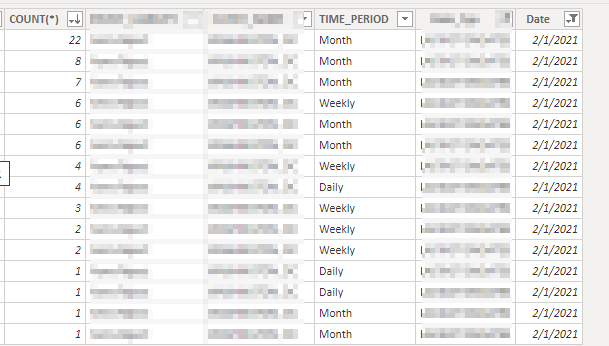Hey Guys,
Need some help on a query - I'm using the below script to get detailed data on a Daily, Weekly, Monthly basis. I'm using unions in the script to categorize the different time periods, so that when I use the dataset in PowerBI, I can add a slicer to select between Daily, Weekly, Monthly.
My question: Is there a better way to write this script without Unions? I believe this is inefficient as it needs to scan the table each time. A single query would be better, but I'm not sure how to write it so that is continues to provide what I'm looking for.......
--Here's the script - It's the same script 3 times but broken down to Daily, Weekly, Monthly.......
select
c.id AS Client_ID
, c.description AS Client_Name
, cl3.code AS Site_ID
, trunc(to_date(v.LAST_ACTION_DTIME),'ddd') AS LastActionDates
, trunc(to_date(v.vio_DTIME),'ddd') AS VioDates
, 'Daily' AS Time_Period
, cl.description AS Reject_reason
, q.queue_name AS Queue_Name
, vt.code AS Vio_type
, decode(cl.value,'Y', 'Controllable', 'N', 'Not Controllable', 'E', 'Non-Event', 'Other') AS Reject_Type
, v.last_action_user
, count()
from
violations v
, clients c
, category_lists cl
, categories cat
, category_lists cl2
, categories cat2
, category_lists cl3
, queues q
, violation_types vt
where
c.id = cl.client_id
and cl.client_id = cat.client_id
and cat.id = cl.category_id
and cl.client_id = v.client_id
and cl.id = v.last_action_id
and cl.value IN ('Y','N','E')
AND v.location_id = cl3.id
AND v.client_id = cl3.client_id
and v.in_use_flag = 'R'
AND v.in_use_flag != 'I'
and cl2.client_id = v.client_id
and cl2.id = v.location_id
and cl2.category_id = cat2.id
and cat2.code = 'LOCATION'
and cat2.client_id = cl2.client_id
and v.vio_type_id = vt.id
and v.LAST_ACTION_DTIME >= to_date('20200101000000', 'yyyymmddhh24miss')
and v.queue_id = q.id
and v.client_id = q.client_id
group by
c.id
, c.description
, cl3.code
, trunc(to_date(v.LAST_ACTION_DTIME),'ddd')
, trunc(to_date(v.vio_DTIME),'ddd')
, cl.description
, q.queue_name
, vt.code
, decode(cl.value,'Y', 'Controllable', 'N', 'Not Controllable', 'E', 'Non-Event', 'Other')
, v.last_action_user
UNION
select
c.id AS Client_ID
, c.description AS Client_Name
, cl3.code AS Site_ID
, trunc(to_date(v.LAST_ACTION_DTIME), 'IW') AS LastActionDates
, trunc(to_date(v.vio_DTIME),'IW') AS VioDates
, 'Weekly' AS Time_Period
, cl.description AS Reject_reason
, q.queue_name AS Queue_Name
, vt.code AS Vio_type
, decode(cl.value,'Y', 'Controllable', 'N', 'Not Controllable', 'E', 'Non-Event', 'Other') AS Reject_Type
, v.last_action_user
, count()
from
violations v
, clients c
, category_lists cl
, categories cat
, category_lists cl2
, categories cat2
, category_lists cl3
, queues q
, violation_types vt
where
c.id = cl.client_id
and cl.client_id = cat.client_id
and cat.id = cl.category_id
and cl.client_id = v.client_id
and cl.id = v.last_action_id
and cl.value IN ('Y','N','E')
AND v.location_id = cl3.id
AND v.client_id = cl3.client_id
and v.in_use_flag = 'R'
AND v.in_use_flag != 'I'
and cl2.client_id = v.client_id
and cl2.id = v.location_id
and cl2.category_id = cat2.id
and cat2.code = 'LOCATION'
and cat2.client_id = cl2.client_id
and v.vio_type_id = vt.id
and v.LAST_ACTION_DTIME >= to_date('20200101000000', 'yyyymmddhh24miss')
and v.queue_id = q.id
and v.client_id = q.client_id
group by
c.id
, c.description
, cl3.code
, trunc(to_date(v.LAST_ACTION_DTIME), 'IW')
, trunc(to_date(v.vio_DTIME),'IW')
, cl.description
, q.queue_name
, vt.code
, decode(cl.value,'Y', 'Controllable', 'N', 'Not Controllable', 'E', 'Non-Event', 'Other')
, v.last_action_user
UNION
select
c.id AS Client_ID
, c.description As Client_Name
, cl3.code AS Site_ID
, trunc(to_date(v.LAST_ACTION_DTIME), 'Month') AS LastActionDates
, trunc(to_date(v.vio_DTIME),'Month') AS VioDates
, 'Month' AS Time_Period
, cl.description AS Reject_reason
, q.queue_name AS Queue_Name
, vt.code AS Vio_type
, decode(cl.value,'Y', 'Controllable', 'N', 'Not Controllable', 'E', 'Non-Event', 'Other') AS Reject_Type
, v.last_action_user
, count(*)
from
violations v
, clients c
, category_lists cl
, categories cat
, category_lists cl2
, categories cat2
, category_lists cl3
, queues q
, violation_types vt
where
c.id = cl.client_id
and cl.client_id = cat.client_id
and cat.id = cl.category_id
and cl.client_id = v.client_id
and cl.id = v.last_action_id
and cl.value IN ('Y','N','E')
AND v.location_id = cl3.id
AND v.client_id = cl3.client_id
and v.in_use_flag = 'R'
AND v.in_use_flag != 'I'
and cl2.client_id = v.client_id
and cl2.id = v.location_id
and cl2.category_id = cat2.id
and cat2.code = 'LOCATION'
and cat2.client_id = cl2.client_id
and v.vio_type_id = vt.id
and v.LAST_ACTION_DTIME >= to_date('20200101000000', 'yyyymmddhh24miss')
and v.queue_id = q.id
and v.client_id = q.client_id
group by
c.id
, c.description
, cl3.code
, trunc(to_date(v.LAST_ACTION_DTIME), 'Month')
, trunc(to_date(v.vio_DTIME),'Month')
, cl.description
, q.queue_name
, vt.code
, decode(cl.value,'Y', 'Controllable', 'N', 'Not Controllable', 'E', 'Non-Event', 'Other')
, v.last_action_user
-- Thanks for your time!


